
NGC 6240, also known as the Starfish Galaxy, is a nearby ultraluminous infrared galaxy (ULIRG) in the constellation Ophiuchus. It was discovered by French astronomer Édouard Stephan on 12 July 1871.
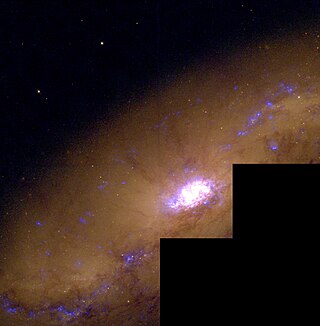
NGC 1808 is a barred spiral galaxy located in the southern constellation of Columba, about two degrees to the south and east of Gamma Caeli. It was discovered on 10 May 1826 by Scottish astronomer James Dunlop, who described it as a "faint nebula". The galaxy is a member of the NGC 1808 group, which is part of the larger Dorado Group.
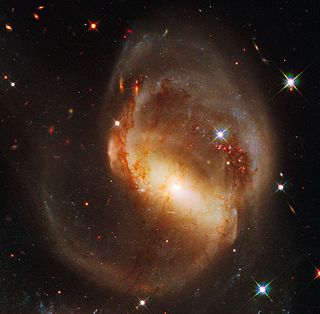
NGC 7319 is a highly distorted barred spiral galaxy that is a member of the compact Stephan's Quintet group located in the constellation Pegasus, some 311 megalight-years distant from the Milky Way. It was discovered on 27 September 1873 by French astronomer Édouard Stephan.

NGC 3432 is an edge-on spiral galaxy that can be found in the northern constellation of Leo Minor. It was discovered by German-British astronomer William Herschel on March 19, 1787. This galaxy is located at a distance of 40 million light-years (12.3 Mpc) from the Milky Way. It is interacting with UGC 5983, a nearby dwarf galaxy, and features tidal filaments and intense star formation. Because of these features, it was listed in Halton Arp's Atlas of Peculiar Galaxies.

NGC 3169 is a spiral galaxy about 75 million light years away in the constellation Sextans. It has the morphological classification SA(s)a pec, which indicates this is a pure, unbarred spiral galaxy with tightly-wound arms and peculiar features. There is an asymmetrical spiral arm and an extended halo around the galaxy. It is a member of the NGC 3166 Group of galaxies, which is a member of the Leo II Groups, a series of galaxies and galaxy clusters strung out from the right edge of the Virgo Supercluster.

NGC 4666 is a spiral galaxy in the equatorial constellation of Virgo, located at a distance of approximately 55 megalight-years from the Milky Way. It was discovered by the German-born astronomer William Herschel on February 22, 1784. It is a member of the Virgo II Groups, a series of galaxies and galaxy clusters strung out from the southern edge of the Virgo Supercluster. John L. E. Dreyer described it as "bright, very large, much extended 45°±, pretty suddenly brighter middle". It is a member of an interacting system with NGC 4668 and a dwarf galaxy, and belongs to a small group that also includes NGC 4632.

NGC 1614 is the New General Catalogue identifier for a spiral galaxy in the equatorial constellation of Eridanus. It was discovered on December 29, 1885 by American astronomer Lewis Swift, who described it in a shorthand notation as: pretty faint, small, round, a little brighter middle. The nebula was then catalogued by Danish-Irish astronomer J. L. E. Drayer in 1888. When direct photography became available, it was noted that this galaxy displayed some conspicuous peculiarities. American astronomer Halton Arp included it in his 1966 Atlas of Peculiar Galaxies. In 1971, Swiss astronomer Fritz Zwicky described it as a "blue post-eruptive galaxy, compact patchy core, spiral plumes, long blue jet SSW".
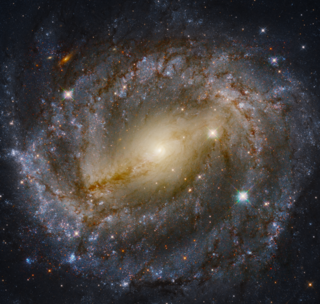
NGC 5643 is an intermediate spiral galaxy in the constellation Lupus. Based on the tip of the red-giant branch distance indicator, it is located at a distance of about 40 million light-years. NGC 5643 has an active galactic nucleus and is a type II Seyfert galaxy.
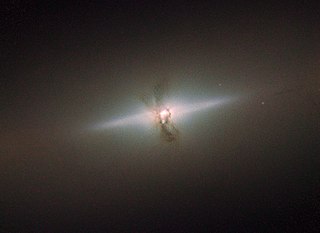
NGC 4111 is a lenticular galaxy in the constellation Canes Venatici. It is located at a distance of circa 50 million light-years from Earth, which, given its apparent dimensions, means that NGC 4111 is about 55,000 light-years across. It was discovered by William Herschel in 1788. NGC 4111 possesses both thin and thick discs.

NGC 6810 is a spiral galaxy approximately 87 million light-years away from Earth in the constellation of Pavo.

NGC 3256 is a peculiar galaxy formed from the collision of two separate galaxies in the constellation of Vela. NGC 3256 is located about 100 million light-years away and belongs to the Hydra–Centaurus Supercluster complex. NGC 3256 provides a nearby template for studying the properties of young star clusters in tidal tails. The system hides a double nucleus and a tangle of dust lanes in the central region. The telltale signs of the collision are two extended luminous tails swirling out from the galaxy. The tails are studded with a particularly high density of star clusters. NGC 3256 is the most luminous galaxy in the infrared spectrum located within z 0.01 from Earth.

NGC 7469 is an intermediate spiral galaxy in the constellation of Pegasus. NGC 7469 is located about 200 million light-years away from Earth, which means, given its apparent dimensions, that NGC 7469 is approximately 90,000 light-years across. It was discovered by William Herschel on November 12, 1784.

NGC 7130 is a spiral galaxy located in the constellation Piscis Austrinus. It is located at a distance of about 220 million light years from Earth, which, given its apparent dimensions, means that NGC 7130 is about 100,000 light years across. It was discovered by John Herschel on September 25, 1834, and discovered independently by Lewis Swift on September 17, 1897. The location of the galaxy given in the New General Catalogue was off by 30 arcminutes in declination from the location of the galaxy.

NGC 1380 is a lenticular galaxy located in the constellation Fornax. It is located at a distance of circa 60 million light years from Earth, which, given its apparent dimensions, means that NGC 1380 is about 85,000 light years across. It was discovered by James Dunlop on September 2, 1826. It is a member of the Fornax Cluster.

NGC 1386 is a spiral galaxy located in the constellation Eridanus. It is located at a distance of circa 53 million light years from Earth, which, given its apparent dimensions, means that NGC 1386 is about 50,000 light years across. It is a Seyfert galaxy, the only one in Fornax Cluster.
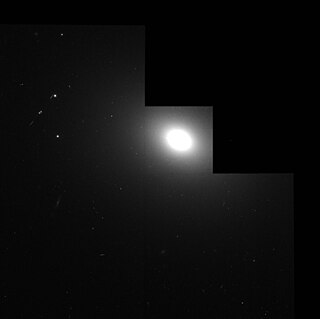
IC 1459 is an elliptical galaxy located in the constellation Grus. It is located at a distance of circa 85 million light-years from Earth, which, given its apparent dimensions, means that IC 1459 is about 130,000 light-years across. It was discovered by Edward Emerson Barnard in 1892.

UGC 5101 is a galaxy merger located in the constellation Ursa Major. It is located at a distance of about 530 million light years from Earth. It is an ultraluminous infrared galaxy. The total infrared luminosity of the galaxy is estimated to be 1011.95 L☉ and the galaxy has a total star formation rate of 105 M☉ per year.

NGC 5135 is a barred spiral galaxy located in the constellation Hydra. It is located at a distance of about 200 million light years from Earth. It was discovered by John Herschel on May 8, 1834. It is a Seyfert galaxy.
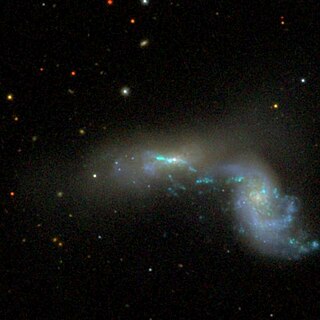
NGC 3396 is a peculiar barred irregular galaxy in the constellation Leo Minor. The galaxy lies about 80 million light years away from Earth, which means, given its apparent dimensions, that NGC 3396 is approximately 85,000 light years across. It was discovered by William Herschel on December 7, 1785.

IRAS 19254-7245, more commonly referred as the "Superantennae", are a pair of interacting galaxies located in the constellation of Pavo. It is located 820 million light years from Earth. It is an ultraluminous infrared galaxy and a Seyfert galaxy.





















